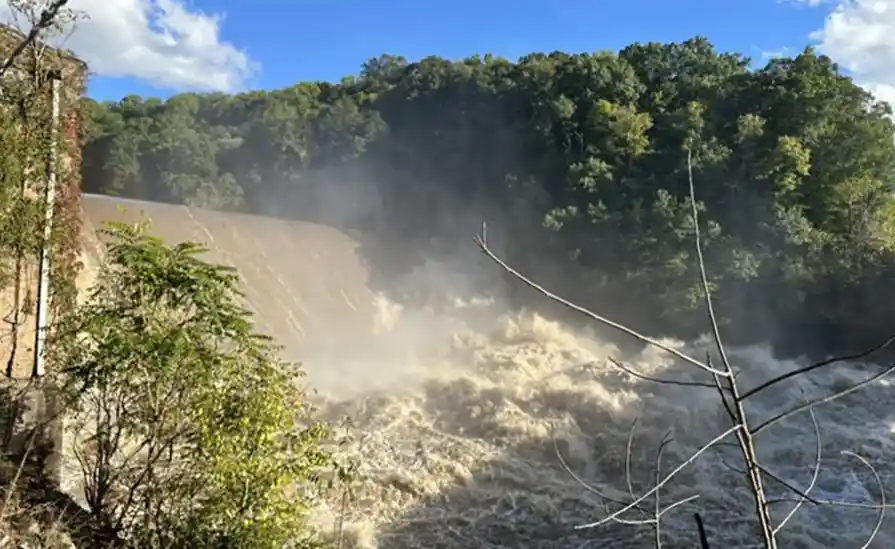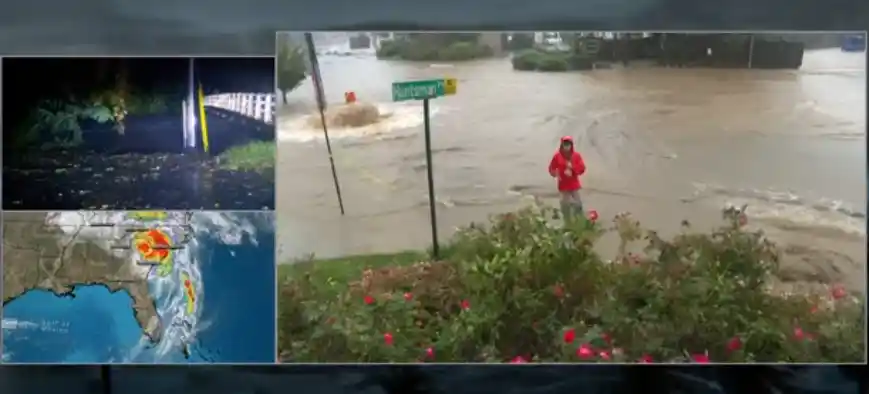
Hurricane Helene, one of the most powerful storms to ever hit the Southeast, has left a trail of devastation in its wake. After making landfall as a Category 4 hurricane with winds reaching 140 mph in Florida’s Big Bend region, Helene has caused catastrophic damage across multiple states, resulting in widespread flooding, destruction, and loss of life.
As communities struggle to cope with the aftermath, rescue missions and recovery efforts continue. Here’s a detailed breakdown of the devastation and the ongoing response to this historic storm.
Death Toll Rises Across Five States
Hurricane Helene has claimed at least 49 lives across five states. Helene hit South Carolina the hardest, with 19 confirmed fatalities, including two firefighters who tragically lost their lives in Saluda County.
In Georgia, the storm claimed 15 lives, with two deaths caused by a tornado in Alamo.
Florida, where the storm first made landfall, has reported eight deaths, with several drowning victims in Pinellas County.
North Carolina has reported six fatalities, including a heartbreaking incident where a 4-year-old girl died in a car crash on rain-slicked roads. In Virginia, one person lost their life when a tree fell and caused a building collapse in Craig County.
Massive Rescue Operations Underway
Following Helene’s destruction, authorities launched large-scale rescue missions across the affected regions. In Florida alone, they deployed nearly 4,000 National Guardsmen to assist with rescue operations across 21 counties. Neighboring states such as North Carolina, Georgia, and Alabama have also activated their National Guard units.
On a federal level, more than 1,500 personnel have been mobilized to support disaster-stricken areas, according to Vice President Kamala Harris.

Severe Flooding in North Carolina
North Carolina has suffered some of the worst impacts from Helene. Governor Roy Cooper called it one of the state’s most catastrophic storms. Torrential rains pummeled the western part of the state, with over 2 feet of rainfall in some areas.
The town of Busick received a staggering 29.58 inches of rain in just 48 hours. This led to widespread flooding, power outages, and numerous landslides across the region.
In Asheville, over 100 people were rescued from rising floodwaters, prompting a citywide curfew. The curfew was imposed to ensure public safety during the emergency.
Meanwhile, the Lake Lure Dam, located southwest of Asheville, faced imminent failure. Relentless rainfall increased the dam’s risk, prompting urgent warnings from the National Weather Service.
Helene’s Impact Extends Far Beyond the Southeast
The remnants of Helene continue to affect a broad swath of the Eastern U.S., bringing heavy rains and gusty winds to regions hundreds of miles from the storm’s landfall point.
Multiple states, including parts of Tennessee, South Carolina, and Virginia, have experienced flash floods, with over a million residents under flood emergency warnings. Winds as strong as 50 mph battered the Ohio and Tennessee valleys, putting millions of people on high alert as the storm’s path extended further inland.
Widespread Power Outages Leave Millions in the Dark
As Helene moved inland, it left more than 3.3 million people without power across several states, including South Carolina, Georgia, North Carolina, Florida, and Ohio. The relentless storm surge and winds brought down power lines and caused extensive damage to electrical infrastructure, complicating restoration efforts. Power companies are working around the clock to restore services, but full recovery could take days, if not weeks.
Disruption of Travel and Essential Services
Hurricane Helene has caused significant disruption to transportation and Delivery giants UPS and FedEx have suspended or limited their operations in the hardest-hit states.
Flooding, mudslides, and other storm-related damages have closed 290 roads in North Carolina. Governor Roy Cooper warned that as the situation worsens, officials may need to close even more roads in the coming days.
Dramatic Rescues Amid Helene’s Chaos
Rescue teams airlifted over 50 people from the roof of Unicoi County Hospital in Tennessee after rapidly rising floodwaters cut off all ground evacuation routes.
Meanwhile, rescue teams are also keeping a close watch on the Nolichucky Dam, where heavy rainfall threatens its stability, potentially endangering nearby communities with catastrophic flooding.
Helene Now a Post-Tropical Cyclone, But Dangers Linger
Although Helene has weakened into a post-tropical cyclone, it remains a significant threat. The National Hurricane Center reports that Helene’s winds have reduced to 35 mph, and it no longer possesses a well-defined center of circulation.
However, officials warn that the storm’s ability to cause heavy rainfall and strong winds has not diminished. Keith Turi of FEMA has urged residents to avoid floodwaters, as they pose numerous hidden dangers, such as submerged debris and contaminants.

Florida and Georgia Communities Devastated by Helene
In the wake of the storm, communities across Florida and Georgia have been left in ruins. Cedar Key, a coastal town in Florida, has been particularly hard hit. With no power or clean water, officials have deemed the area unsafe for residents or volunteers to return.
The small, tight-knit community has seen historical buildings destroyed, homes wiped out, and roads blocked by dangerous debris.
Helene has decimated Keaton Beach, a Florida community, leaving almost every home destroyed, according to Florida Governor Ron DeSantis.
The storm surge, which may have reached up to 20 feet, completely obliterated some homes. Now, residents are sifting through the wreckage, wondering what to do next.
One such resident, Eric Church, described the devastation as overwhelming after losing his home, expressing despair over the uncertain future for his family.
Rescue Stories: Acts of Heroism Amid the Storm
Amid the chaos, there have been stories of heroism. One such story involves U.S. Coast Guard swimmer Ted Hudson, who rescued a man and his dog from their houseboat near Sanibel Island, Florida.
Battling 60 mph winds and dangerous waves, Hudson bravely swam to the stranded pair and helped airlift them to safety in a daring operation caught on camera.
The Road to Recovery
Hurricane Helene’s impact on the Southeastern U.S. is far from over. Moreover, Communities are still grappling with the storm’s devastation, and the long recovery process has just begun. As rescue missions continue and the threat of flooding persists, residents are urged to remain cautious.
The aftermath of Helene serves as a stark reminder of the destructive power of nature and the resilience of those who face it head-on. With federal, state, and local agencies working together, the path to recovery, though challenging, is already underway.





